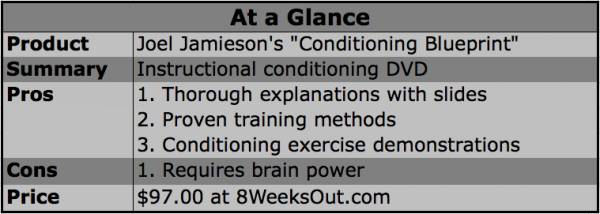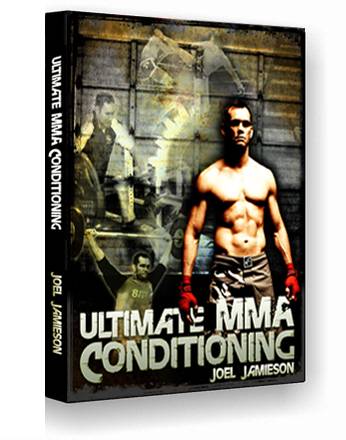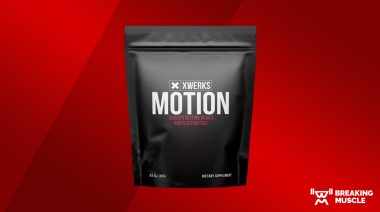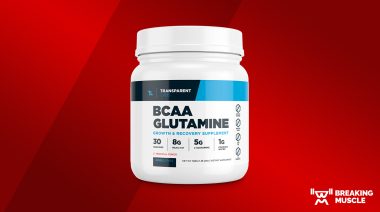

Last year I traveled to Montreal, Quebec to compete in my first IBJJF tournament. To improve my strength and conditioning for the tournament, I followed the advice in Joel Jamieson’s book, Ultimate MMA Conditioning.
During my training, since I worked full time, trained in the evenings, and traveled on the weekends, I didn’t have a lot of time to read and absorb the whole book. However, I was able to apply some of the key concepts to my training and am glad to say that I didn’t gas out at all during the tournament.
Since then, Joel sent me a copy of his Conditioning Blueprint DVD to review, and I realize now that I could have done an even better job in planning my training blocks. In Conditioning Blueprint, Joel explains some of the most common mistakes trainers make and provides proven techniques to better train athletes for their sports.
The DVD set is broken down into four modules:
Module 1: Conditioning Essentials
In this module, Joel explains how energy systems work and how athletic training affects the body. He also discusses theories about what causes fatigue. Conditioning is a measure of maximum sustainable power output over a given duration. The more power you can exert over a longer time, the better your conditioning will be. Performance comes with good conditioning and a smart use of energy.
I found the lecture in this module a little too complicated at first, but I watched it a couple of times, and since then, I can apply it directly to my training in BJJ. I can see how a new athlete will burn out after giving it his or her all after sixty to ninety seconds, and I understand now that if that athlete improves his or her aerobic capacity he or she will not fatigue as quickly.
The cause of fatigue is something we can’t fully explain, because there are so many variables such as temperature, hydration, glycogen levels, and oxygen supply to the brain. The brain has to make sure it has energy, so it makes your muscles slow down. You’re going to fatigue differently in different sports. Joel explains how understanding the anaerobic power reserve is essential to conditioning and why aerobic fitness is essential to maintaining power output in athletic endeavors.

Module 2: Methods of Conditioning
In this module, Joel begins with an explanation of how to measure fitness levels in athletes and then provides a variety of methods to improve aerobic capacity and conditioning. Joel explains how each of the methods affect the body, how long to do each of the techniques, and when to use them. He works with professional baseball player Howie Clark to demonstrate all of the different methods.
Module 3: How to Write Effective Conditioning Programs
In this module, Jamieson explains how to evaluate athletes in their sport to discover what their strengths are and what they need to work on. This module teaches trainers and athletes how to plan block training to meet their goals or sets of goals. Exercises, methods, intensity, volume, and overall load are decided upon and organized into weekly, monthly, and annual programs, depending upon what’s happening with competition. Sample programs are provided and explained for soccer and MMA.
Module 4: Principles of Conditioning Program Management
Why manage the training process? Joel explains that there are two reasons. The first is to prevent the body from being pushed to a state of overtraining where negative adaptations result. The second reason is to produce maximum results in minimum time by optimizing the loading according to the individual athlete’s ability to recover and adapt to training and other stress.
Jamieson identifies different tools that can be used regularly to monitor progress and recovery including his own invention, BioForce HRV, as well as several free measurement tools. I have the BioForce HRV system and it is a great tool to determine whether your training is working and to improve your overall conditioning. Regular HRV monitoring also helps athletes to prevent overtraining and to plan their training load for best results.
One thing Joel stresses is that communication between the trainer and athlete is important to eliminate any disconnect between how hard the trainer thinks the athlete is working and how hard the athlete feels he or she is working. Sometimes trainers are unaware of what is happening in an athlete’s life outside of training, and Joel talks about the balancing act with training load, training frequency, history, fitness level, nutrition, mental stress, genetics, and sleep.
This DVD set isn’t like most strength and conditioning instructionals. Joel Jamieson doesn’t just give you a cookie cutter program, walk you through the exercises and tell you to follow along three times a week. The best way to describe Conditioning Blueprint is the Maimonides quote, “Give a man a fish and you feed him for a day; teach a man to fish and you feed him for a lifetime.” Conditioning Blueprint comes with a lifetime guarantee, so if you’ve bought the DVD set and have not found it useful, you can return it at any time and get your money back.
I think Conditioning Blueprint is best suited for training professionals who are helping clients prepare for their particular sports. However, if you’re an athlete who wants to improve your strength and conditioning but you don’t have a coach, or you want to make sure your coach knows what he or she is doing, you would benefit from watching this DVD set. Be aware that these training tools are for people who are serious about improving their conditioning. They require focus and attention to get what you need out of them. They’re not even close to Shape magazine. Or Jakt magazine, if it exists.

I recommend using Conditioning Blueprint with Joel Jamieson’s book, Ultimate MMA Conditioning, for best results. The first time I tried to read through the book I found it complicated and gave up a lot of times without completing the whole thing. Now that I’ve seen the DVDs, I feel as though I have a better understanding of Joel’s training concepts and the book is easier to work with. It has a lot of the same information as the DVD set, but I found it easier to follow along with when trying to develop my own program.
The DVD set offers video instruction on how to do a lot of the conditioning exercises recommended in the book, which helps a lot, but the strength portion of programming is not provided. I feel more able to create an effective program for myself now that I’ve reviewed both.
“Conditioning Blueprint” is available for $97.00 from 8WeeksOut.com.






